Budget and Fiscal Plan 2004/05 – 2006/07
February 17, 2004 • Ministry of Finance
SUMMARY
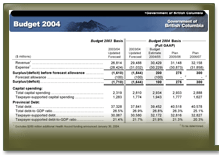 |
 |
Budget 2003
Basis and Budget 2004 Basis |
 |
 |
 |
 |
 |
 |
 |
Balanced, Transparent and Accountable
Budget 2004 delivers on government's legislated commitment
to balance the budget beginning in 2004/05. The updated fiscal plan
projects surpluses for 2004/05 and the following two fiscal years.
A $100 million surplus is forecast in 2004/05, followed by
$275 million and $300 million surpluses in 2005/06 and
2006/07 respectively.
Over and above the $100 million forecast surplus, the 2004/05
budget includes a $240 million contingency reserve for unexpected
spending requirements by government ministries. A further $100 million
forecast allowance is available to protect the bottom line from
shortfalls in revenue and other spending areas.
The three-year fiscal plan conforms to the standards set by the
accounting profession for senior governments in Canada referred
to as generally accepted accounting principles or "GAAP". The main
change required to fully comply with GAAP in 2004/05 has been to
integrate the financial forecasts of the schools, universities,
colleges and health authorities (the SUCH sector) into government's
revenue, spending and balance sheet projections.
Consistent with government's accountability framework, the three-year
fiscal plan is complemented by the service plans for government
ministries and Crown corporations that detail their goals, objectives
and performance targets. Government ministers and ministers of state
are also subject to ministerial salary deductions if financial or
performance targets are not achieved.
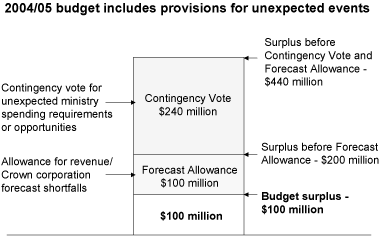
Affordable Plan, Focused on Services to People
Since Budget 2003, government has committed increased
revenues and savings from other areas to the priority areas of health
care and education. Additional funding has been provided for services
to children and vulnerable adults, and income assistance for people
in need. By 2006/07, the health care budget will have increased
by over 10 per cent since February 2003 to total
$11.3 billion. This increase includes new commitments to long
term care and service expansion in Budget 2004 as well
as the Health Accord funding allocated after Budget 2003. Over
the next three years, budgets for the K-12 and post secondary ministries
will increase by over 6 per cent to total $7.2 billion.
Ministry programs other than health care and education show a small
decline between 2003/04 and 2006/07.
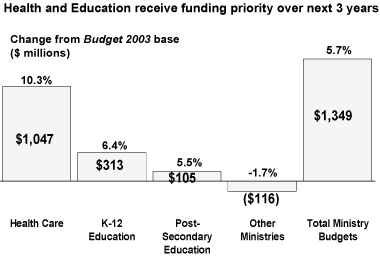
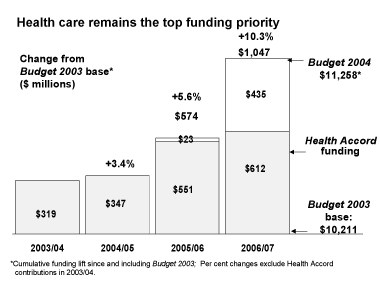
Health Care Funding
Over the next three years, health care receives the largest funding
increase among ministries, with additional federal revenues fully
committed to health services. Starting in 2005/06, funding has been
added to support continuing care and the new Abbotsford Regional
Hospital and Cancer Centre. In 2006/07, government's priority allocation
of available revenues has been to meet the growing demand for health
care. Capital commitments to the health system include new equipment
such as beds, lifts, incubators, and ultrasound, CT and X-ray imaging
equipment.
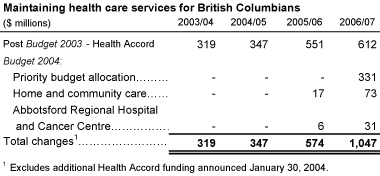
BC's estimated $260 million share of the additional $2 billion
in federal health funding announced on January 30, 2004
is not included in Budget 2004. The new funds are expected
to be committed to the health care budget in 2004/05 and 2005/06
once details of the transfer arrangements are known and the accounting
treatment is confirmed.

Education
The government continues to develop a top-notch education system
for students of all ages. Additional funds have been provided in
Budget 2004 to expand access to post secondary education,
with seat growth rising to 2.6 per cent annually by 2005/06.
Over the next three years, almost 12,000 seats will be added, and
25,000 new spaces will have been achieved at BC's universities and
colleges by 2010. An expanded student loan program will ensure students
in need have access to funding to pursue their education. In addition,
completion grants and loan remissions are also under consideration.
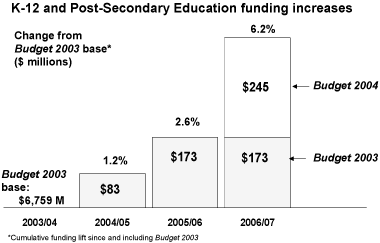
New K-12 funding in 2006/07 will target greater student achievement
as well as address additional seismic mitigation measures in the
school system.
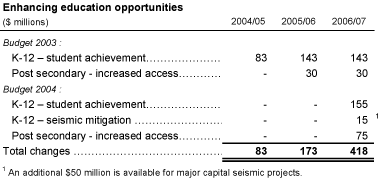
Promoting Economic Growth and Resource Development
British Columbia is building a strong, vibrant and competitive
economy that has:
- the lowest personal income tax rates in Canada for the bottom
two income tax brackets;
- the second lowest top marginal income tax rate in Canada;
- one of the lowest small business corporate income tax rates;
- no corporation capital tax for general corporations; and
- a regulatory burden on track to be cut 30 per cent
by June 2004, having already been reduced by nearly 90,000
regulations since June 2001.
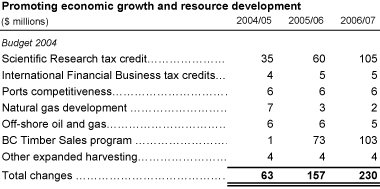
Budget 2004 also provides funds to expand the BC Timber
Sales program and increase the amount of auctioned timber, develop
the energy sector, extend the Scientific Research and Experimental
Development Tax Credit, expand the international financial business
program and to support the competitiveness of BC ports.
Budget 2004 includes $1.9 billion of capital spending
on schools, health care facilities, roads and other projects to
support both enhanced public services and economic growth in BC.
The Vancouver Convention Centre Expansion Project leverages federal
and private sector funding to create a facility that will generate
significant returns to the economy. Transportation capital spending
includes components of the Transportation Investment Plan that also
spur economic development. These include the Sea-to-Sky highway
upgrade, investment in oil and gas roads, the Kicking Horse Canyon,
Northern and Heartlands Roads, and the Vancouver Gateway.


2010 Olympic and Paralympic Winter Games
On July 2, 2003, Vancouver was chosen as the host city for the
2010 Olympic and Paralympic Winter Games. Budget 2004
includes accelerated funding to support construction and management
of the games, including:
- $51 million in 2003/04 to fund Olympic venues;
- $55 million in 2003/04 towards an endowment supporting
the ongoing operation of those venues; and
- an additional $111 million from 2004/05 to 2006/07 to fund
Olympic venues.
Spending authority for $72 million to begin building games
venues will be provided by a Supplementary Estimate in 2003/04.
All these expenditures are within the previously announced $600 million
envelope for the Games.
Communities and Safety
Budget 2004 supports government's objectives for safe
and supportive communities. Since last year's budget, funding for
employment assistance and for protecting vulnerable children and
families has been increased. Increases are also provided for policing,
and the cost of the missing persons investigation in Port Coquitlam.
In addition, the Home Owner Grant phase-out threshold has been increased
to $585,000 from $525,000.
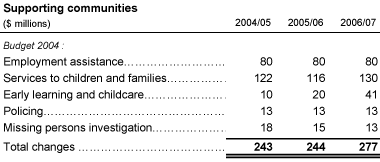
Crown corporations restructured
Subsequent to core services and energy policy reviews, government
policy now encourages private sector investment in the energy and
auto insurance sectors, and provides independently regulated rates
for ICBC and BC Hydro. In addition, consumers have increased
choice in auto insurance and have retained the low-cost benefits
of BC's hydro generation system.
In the fiscal plan, BC Hydro's net income forecast reflects
the interim rate increase approved by the BC Utilities Commission
in January 2004.
The BC Rail Investment Partnership enables CN Rail to
assume responsibility for BC Rail's freight operations, while
providing funds for reinvestment in Northern and First Nations communities.
There is no impact on government's bottom-line from this initiative,
as the net income from the transaction will be offset in the same
fiscal year by commitments to the Northern Development Initiative,
the BC Rail First Nations Benefits Trust, Legacies Now and
other priority areas. BC Rail's $479 million debt will also
be paid down. These transactions are expected to occur in the 2003/04
fiscal year, but could be delayed until 2004/05 depending on the
timing of the federal Competition Bureau review.

2003/04 Updated Forecast
For the 2003/04 fiscal year, the deficit is forecast to be $1.71 billion
(excluding the SUCH sector), after including a $100 million
forecast allowance. This is $590 million lower than budget.
The $434 million additional costs for forest fires, floods
and BSE, and an $824 million loss of equalization revenues were
offset by improvements in taxation, energy, Crown corporation and
other revenues. In addition, lower debt interest costs and ministry
savings have allowed $138 million to be committed to key priorities
including accelerated funding for the 2010 Olympics.
When the SUCH sector is included, the 2003/04 deficit is forecast
to be $1.64 billion.

Economic growth expected to pick up
The Ministry of Finance is expecting economic growth of 2.8 per cent
for 2004 and 3.1 per cent in 2005 and 2006. The independent
Economic Forecast Council consensus is for slightly higher growth.
Revenue growth of 3.2 per cent is forecast in 2004/05,
led by increasing taxation revenues. In 2005/06 and 2006/07, revenue
is forecast to grow an average 2.8 per cent per year.
Now that a balanced budget is forecast, future economic growth provides
the basis for expanded service levels, lower tax rates and/or debt
repayment.
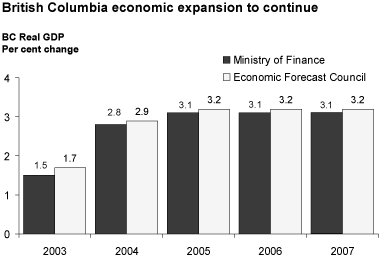
Debt growth curtailed
Government debt at the end of 2003/04 is forecast to total $37.8 billion,
$3.6 billion less than budget. This results from a lower than
expected deficit, lower debt at the start of the year, reduced capital
spending, and the defeasance of BC Rail's debt. Compared to
Budget 2003, lower debt interest costs in 2004/05 and
future years result from reduced borrowing requirements. The taxpayer-supported
debt-to-GDP ratio is forecast to show an improving trend as planned
surpluses reduce future borrowing requirements.
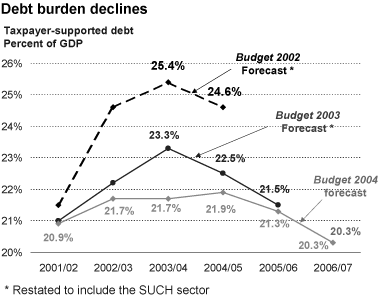
|














